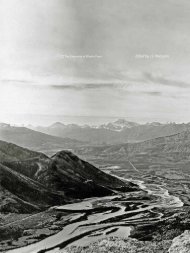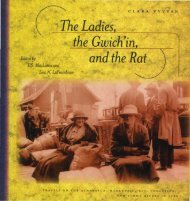Paul Kane's Journal of his Western Travels, 1846-1848 - History and ...
Paul Kane's Journal of his Western Travels, 1846-1848 - History and ...
Paul Kane's Journal of his Western Travels, 1846-1848 - History and ...
You also want an ePaper? Increase the reach of your titles
YUMPU automatically turns print PDFs into web optimized ePapers that Google loves.
Nez Perce) (est. 1818) was visited by Kane December 2-4,<br />
<strong>1846</strong>, <strong>and</strong> July 12 <strong>and</strong> 22- 29, 1847. Situated on the left bank<br />
<strong>of</strong> the Columbia River at the mouth <strong>of</strong> the Walla Walla River<br />
(now Walla Walla, Washington), the post was erected by the<br />
North West Company, <strong>and</strong> rebuilt by the HBC in 1841 with<br />
mud brick walls.<br />
white mud/White Mud As the fur trade did, Kane uses t<strong>his</strong> name<br />
for two portages on the Winnipeg River, one passed on August 4<br />
<strong>and</strong> the other on August 12, <strong>1848</strong>. T<strong>his</strong> name was used for a<br />
portage on the upper river (see Gr<strong>and</strong> Decbarge), <strong>and</strong> for a<br />
portage above Eaux qui Remuent, on the lower river below Lac<br />
du Bonnet (see fall <strong>of</strong> the Pramin Horses or silver fall).<br />
Whitmans, nor/Dr. W. Marcus <strong>and</strong> Narcissa Whitman went to<br />
Oregon in 1836 <strong>and</strong> established a Congregationalist mission at<br />
Waiilatpu (near Fort Walla Walla). On November 29, 1847,<br />
four months after Kane had visited them, they were slain.<br />
Cayuse visitors to the mission mwdered them <strong>and</strong> twelve others,<br />
<strong>and</strong> held fifty-three people captive Wltil they were ransomed by<br />
the HBC. In t<strong>his</strong> fashion, the Cayuse wars began.<br />
wiDhamed The Willamette River (Oregon) was first explored by<br />
the Astorians (see Astoria) in 1812. In 1829, its valley was<br />
farmed for the first time by whites. It flows from south to north,<br />
entering the Columbia River near Portl<strong>and</strong>, Oregon. In 1842, the<br />
HBC established Oregon City at the faUs <strong>of</strong> the Willamette.<br />
<strong>Kane's</strong> journal does not recoWlt <strong>his</strong> trip in the valley, January II<br />
to February 6, 1847. The Clackama, a Chinook tribe, lived on<br />
the Clackamas River, a tributary that joins the Willamette River<br />
from the east at Oregon City .<br />
WiIk's party, Capt Charles Wilkes (1798-1877) was the American<br />
naval <strong>of</strong>ficer appointed in 1830 to head the Depot <strong>of</strong> Charts<br />
<strong>and</strong> Instnunents. In May, 1841, with other <strong>of</strong>ficers, servants,<br />
two Indians, <strong>and</strong> a voyageur, he examined the overl<strong>and</strong> route<br />
between Nisqually <strong>and</strong> Fort Vancouver, as part <strong>of</strong> <strong>his</strong> global<br />
survey with the United States Exploring Expedition.<br />
Willam/Willum See Fort WiUam/fort WiIIam/WiUwn.<br />
Winepeg River Winnipeg R!ver flows north for 500 miles from<br />
Lake <strong>of</strong> the Woods to Lake Winnipeg. The name comes from<br />
win-nipi, the Cree for "murky water." TIle name could not be<br />
less appropriate for t<strong>his</strong> river. It fonned a singular part <strong>of</strong> the fur<br />
trade route to <strong>and</strong> from Lachine (near Montreal), although it<br />
presented twenty-six different carrying places. Now harnessed<br />
by six hydroelectric projects, its spectacular beauty, as it tumbled<br />
over the Canadian Shield, made it the most arresting, if<br />
laborious, part <strong>of</strong> the transcontinental route. For descriptions <strong>of</strong><br />
various features <strong>of</strong> the river, see Barriere portage, Bek:our,<br />
Mr., Gr<strong>and</strong> Bonet, Gr<strong>and</strong> Decbarge, Gr<strong>and</strong> GuUete,<br />
Gr<strong>and</strong> raped, Lake de Bonet, little rock, Point <strong>of</strong> W~,<br />
rapid de gock/Chute a Jocka, River NaIoin, Roches Bru.Ies,<br />
<strong>and</strong> white mud/White Mud.<br />
wodin Horse Cheval de bois (Wooden Horse) was one <strong>of</strong> the<br />
seven portages in Blanche River (see River NaIoin).<br />
YaDo Mud See Gr<strong>and</strong> Decbarge.<br />
York Fa ctary York Factory (est. 1684) was not visited, only<br />
mentioned, by Kane. The first HBC fort, it was named for the<br />
Duke <strong>of</strong> York, later King James II, second Governor <strong>of</strong> the<br />
HBC. Located on Hudson Bay at the mouth <strong>of</strong> the Nelson<br />
Ri ver, t<strong>his</strong> post loaded furs transported from inl<strong>and</strong> posts onto<br />
HBC ships sailing for Engl<strong>and</strong> through Hudson Strait. During<br />
<strong>his</strong> first stay at Norway House, Kane was awaiting the arrival<br />
<strong>of</strong> the brigade from York Factory, returning from its annual<br />
early summer descent to the Bay, en route in August back to the<br />
posts <strong>of</strong> the western interior.<br />
The American Art <strong>Journal</strong>/Volume XXI • Number 2<br />
87
















